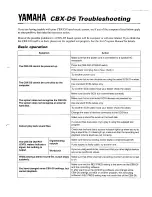
3
Copyright © 2021, Waterite, Inc. All Rights Reserved
FREQUENTLY ASKED QUESTIONS
What factors affect the quality of the water produced?
1. Pressure: The greater the RO system pressure, the greater the water quantity that will be produced by the membrane.
a. The VectaMaxx™ RSL units have been equipped with ultra-low energy membrane(s) that are designed to operate at a
minimum system pressure of 100 psi and a maximum of 135 psi for 2400 and 4800 models, 140 psi for 7200 and 9600
models. Do not attempt to operate your RSL system at pressures exceeding 150 psi, as damage to the membrane or
premature fouling may result.
b. The VectaMaxx RSLHP units have been equipped with brackish water membranes that are rated for 225 psi. All RSLHP
units are designed to operate to a maximum pressure of 250 psi.
2. Temperature: Production increases with temperature, standard production ratings are established at 77ºF (25ºC). Never
operate the system from the hot water line or with water exceeding 95ºF (35°C), as this will damage the membrane and
internal components.
3. Membrane type: VectaMaxx™ RSL systems use premium quality TFC (Thin Film Composite) membranes, specially chosen
for general commercial applications. Please contact your dealer for information on special applications or nanofiltration
membranes.
4. TDS: Higher TDS (Total Dissolved Solids) in the raw water lowers the output and quality of product water.
How much water will my system produce?
The VectaMaxx™ RSL systems use membranes each nominally rated for 2400 gallons per day (GPD). Actual output will be dependent
upon the factors noted previously. In optimal applications (low feed water TDS, feed water of 77ºF or 25ºC), you may expect up to 1600-
2200 GPD from each membrane over a 24-hour period.
The VectaMaxx™ RSLHP units use membranes each nominally rated for 2000 GPD. Actual output will be dependent upon the factors
noted previously. In optimal applications, feed water at 77°F (25ºC), you may expect 1300-1800 USG from each membrane over a 24-
hour period. Consult your water treatment professional for a production estimate based on your specific water conditions.
If your system is equipped with the Pretreat Lockout option, no production will be available during the Pretreat regeneration cycle. This
will prevent the system from operating periodically with untreated feed water and prolong the life of the filter and membranes.
How can I get more water?
The overall quantity of water available for consumption over a 24-hour period can be improved by increasing storage capacity. This will
allow the system to produce water in off-peak hours instead of sitting idle. This will also increase storage capacity available during peak
hours when water usage may exceed production capacity.
What is the maintenance schedule for the system?
The pre-filter should be changed monthly in most commercial applications. Consider changing them biweekly when in continuous use
or when used with untreated water sources. Depending on feed water quality, your membrane(s) should have a life expectancy of 1-3
years. More severe water conditions (iron, hardness) may shorten this significantly; soft water sources may allow a membrane life of
up to 5 years.
Do membranes wear out?
As your membrane ages, it will gradually lose some output. This is normal and may result in a production loss of 5% after about 1 year.
Your membrane(s) may eventually begin to lose production due to fouling or scaling in its interior. Symptoms of this may be continuously
falling production rates or elevated TDS levels in the product water. Do not attempt to operate the system above specified pressures
to compensate for output loss. Membrane element life will range from 1 to 3 years, depending on the quality of the feed water. See:
Section 3: System Maintenance for membrane removal and installation instructions.
It is a good idea to always keep an extra membrane(s) on hand to avoid system downtime. Never allow a membrane to dry out
(if wet variety) or freeze while in storage.
When should the membrane(s) be changed?
If you notice gradually decreasing production from your system, differing taste to your drinking water or a rising Total Dissolved Solids
reading, it means that your membrane(s) are deteriorating and losing effectiveness. The TDS meter on the unit will measure the TDS
of feed water and the product water.
Where the RO system is used as a pre-treatment for a process requiring water to exact standards, you should adopt a regular ongoing
sampling and testing procedure to ensure compliance, as product water will vary with the quality of the feed water.




































